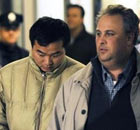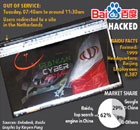Op-Ed Contributors
Non-proliferation: Onus is on major nuclear states
By Ming Jing (China Daily)
Updated: 2010-01-14 07:52
 |
Large Medium Small |
This year will be crucial for nuclear arms control.
The non-proliferation review conference in May could decide whether the global non-proliferation regime survives or not. And all eyes will be on the United States and Russia to see if the two top atomic powers can reach a deal to reduce their nuclear arsenals.
Delivering a speech in Prague in April, US President Barack Obama said his country was committed to seeking "a world without nuclear weapons". Five months later, he chaired a meeting of the UN Security Council, which unanimously supported his vision.
| ||||
The success of the month-long review of the troubled 1970 Nuclear Non-Proliferation Treaty (NPT) will depend largely on whether the American and Russian negotiators agree on a successor pact to replace the 1991 Strategic Arms Reduction Treaty (START-1) to cut nuclear weapons.
The US and Russia missed their deadline in December to agree to a new arms control treaty, which would have cut the world's two largest nuclear arsenals by up to a third, though they vowed to generally abide by the old one while continuing negotiations.
The overall outline of the new treaty is apparent. At a meeting in Moscow in July, Obama and Russian President Dmitry Medvedev narrowed the range for a cap on warheads to between 1,500 and 1,675, down from about 2,200, which each side now has. They are also expected to lower the ceiling on delivery vehicles - intercontinental ballistic missiles, submarine-based missiles and strategic bombers - to below 800, from 1,600.
Both sides say a successor to START-1 would help restore relations between Moscow and Washington, which recently sank to a post-Cold War low. The new treaty should become another milestone in disarmament and non-proliferation, taking the interaction between the US and Russia to a higher level and reaffirming their common goal of promoting mutual as well as global security.
But with the US and Russia still grappling over a few key differences, there are no guarantees that talks would yield a provisional accord. Russia has called for simpler verification procedures for planned cuts in nuclear arsenals, while the US insists on a deal that works for the two Cold War foes.
Analysts reckon that the deadline for a new agreement is May, when the non-proliferation review conference opens in New York. The last review conference, in 2005, ended in failure. The promise of the 1995 review conference has not been realized, either. Despite doing remarkable work in many countries, the International Atomic Energy Agency is still short of expertise and resources. Although the present non-proliferation regime has played a positive role in preventing proliferation, it has its shortcomings: limited binding force, lack of effective measures of supervision and sanctions against countries violating the NPT.
With by far the world's two largest nuclear arsenals, the US and Russia have the prime responsibility of taking the lead in disarmament. Hopefully, they will ensure that their disarmament process is verifiable and irreversible and that their dismantled weapons are destroyed and not turned into stockpiles. Any new nuclear-weapon reduction treaty should have a strict verification mechanism, and it is important that the major nuclear powers conduct meaningful strategic dialogues to enhance mutual trust.
If Russia and the US can send a clear signal to the world that they are serious about disarmament by signing a new pact to reduce their Cold War stockpiles, the NPT will get a new lease on life when its 189 signatories gather to discuss ways of plugging what some see as dangerous loopholes.
More importantly, the non-proliferation review conference will be a test: whether the progress in START-1 can be used for a renewed grand bargain between nuclear and non-nuclear countries. Many NPT signatories would like the review conference to call for universality of the treaty - meaning Israel, Pakistan and India should be pressured to sign it and destroy any warheads they might have build.
The Democratic People's Republic of Korea (DPRK) withdrew from the NPT in 2003 and tested nuclear devices in 2006 and again earlier last year. Western powers would also like this year's NPT review to agree on a plan of action for strengthening the treaty to make it harder for countries like Iran and the DPRK to acquire sensitive technology and the capability to make nuclear weapons.
But rich and poor nations have been at loggerheads over the issue for years. Poor states accuse the big powers of maintaining a monopoly on nuclear technology and want that to end.
Wealthy states worry about the threat of nuclear arms races in Asia and in the Middle East, where Israel is widely believed to have a nuclear arsenal, although it does not acknowledge it.
They fear that a resurgence of atomic energy across the world will increase nuclear proliferation risks.
The balance of the bargain will be debated in the non-proliferation review conference, which hopefully will work out effective measures and reach some substantial agreements. The atmosphere at the last preparatory conference was cooperative, though the underlying risks of paralyzing disputes remain high.
But no matter what the outcome of the review conference is, it will still be important for nuclear states to cooperate in maintaining and strengthening non-proliferation - unless the world is prepared to accept unchecked cascades of proliferation that could lead to global nuclear anarchy.
(China Daily 01/14/2010 page9)













